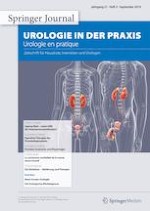Anzeige
06.09.2019 | Originalien
Die Reizblase – Abklärung und Therapie
Erschienen in: Urologie in der Praxis | Ausgabe 3/2019
Einloggen, um Zugang zu erhaltenZusammenfassung
Die Reizblase ist ein Beschwerdebild, bei welchem ein imperativer Harndrang mit oder ohne Dranginkontinenz auftritt. Je nach Ausprägungsgrad kann sie einen signifikanten Einfluss auf die Lebensqualität der Betroffenen haben. Die Prävalenz der überaktiven Harnblase ab dem 40. Lebensjahr beträgt ca. 17 % bei Frauen und Männern und kann mit zunehmendem Alter bis zu 32 % betragen. Zudem stellt sie ein sozioökonomisch relevantes Krankheitsbild dar. Ursächlich können verschiedenste urologische, nichtneurologische sowie neurologische Erkrankungen in Frage kommen. Zur Abklärung ist eine systematische Anamneseerhebung unerlässlich. Diagnostisch sollte stufenweise von der Anamneseerhebung über die klinische Untersuchung zur Laborkontrolle und apparativen Diagnostik (Zystoskopie, Urodynamik, Radiologie) vorgegangen werden, damit nachfolgend eine optimierte Therapie erfolgen kann. Insbesondere bei neurogenen Harnblasenfunktionsstörungen stehen primär der Schutz des oberen Harntraktes und der Blase im Vordergrund, sekundär aber auch die Verbesserung der Lebensqualität, die Erhaltung der Kontinenz sowie die Optimierung der Harnblasenentleerung. Therapeutisch stehen verschiedenste konservative, medikamentöse, elektromodulative und operative Optionen zur Verfügung.
